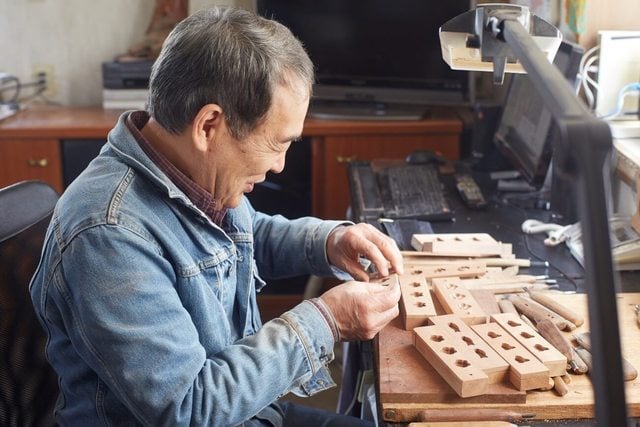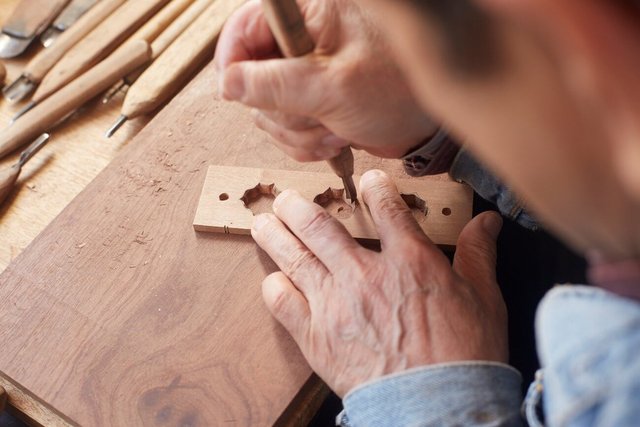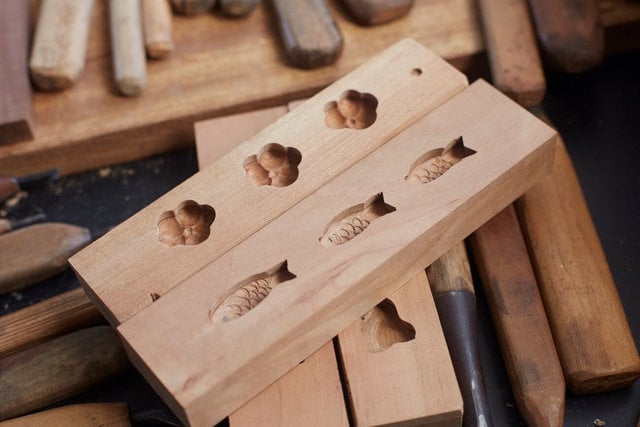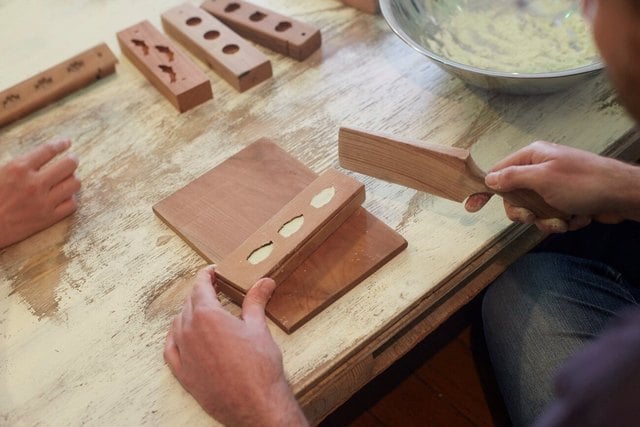Walking into Yoshihiro Ichihara’s workshop in downtown Takamatsu, your senses are immediately struck by the delicate, almost sweet scent of freshly worked wood. Then your eyes take over.
Chisels large and small litter the main workbench where Mr. Ichihara sits, in jeans and a checked shirt, carving the initial outline of a maple leaf into a small rectangular slab of wood.
On a bench behind him are several small machines; a mix of fixed drills, sanders and lathes. Another is home to a small collection of hard-looking, bite-sized pink and white sweets, some
shaped like flower heads, others depicting the faces of cartoon-like characters.
Even in a nation renowned for the breadth, depth and quality of its traditional artisans as Japan, Mr. Ichihara is a rarity. The septuagenarian is the last person in Western Japan
handcrafting the wooden molds (called kashikigata) used to make a type of sugary sweet called wasanbon, a traditional accompaniment to green tea that shares its name with the fine-grained
sugar used to make it.
After decades spent perfecting his craft, Mr. Ichihara makes chiseling intricate patterns into the kashikigata look deceptively simple, chatting away about the weather, acquaintances and anything else that comes to mind while he works.
After decades spent perfecting his craft, Mr. Ichihara makes chiseling intricate patterns into the kashikigata look deceptively simple, chatting away about the weather, acquaintances and anything else that comes to mind while he works.
“The smaller ones are the hardest to make. Faces, too,” he says, his thick, leathery fingers driving a chisel into the wood, as he briefly turns to talking about his craft. “It’s
difficult to make such fine details. The bigger molds look more striking, but they are actually easier to make.”
FROM WOOD TO WASANBON
Whatever the complexity, the process behind it is the same. It all begins with locally sourced 100-year-old mountain cherry wood, which after being felled is dried for two years before
being cut into the basic rectangular blocks Mr. Ichihara works with. Working from a plain slab of wood to penciling on a basic design, chiseling, testing and tweaking, and then to the
finished product takes an average of two days.
There’s almost nothing Mr. Ichihara cannot transform from a 2D image into a 3D mold. Step into the single-room gallery adjoining his workshop and you will see the full range of his work,
kashikigata of all shapes and sizes lining shelves and filling display cabinets, from those for making finger nail-sized skull-shaped sweets to head-sized carp. There’s even a tourism
poster on one wall featuring varicolored wasanbon made with Mr. Ichihara’s molds that depict a range of duty-free items – clothing, home electronics and cosmetics. And if you thought that
after decades of creating so many molds Mr. Ichihara would be tiring of this task, you’d be wrong.
“I work 13 hours a day, every day, without taking holidays,” he says. “I wake up at 6:30 excited to go to my workshop. Come 9:30 at night, I start thinking, ‘oh no, I’ve only got 30
minutes left before I have to go home’. It’s not something I can imagine ever stopping.”
HANDS- ON WITH SWEET TRADITION
A few houses down the street from Mr. Ichihara’s workshop, his daughter, Ayumi Uehara, carries on the family wasanbon tradition with sweet-making workshops. Taught in definitively
Japanese surroundings, sitting on cushions at a low table and with the English-speaking Ms. Uehara providing step-by-step guidance, the process is unexpectedly simple, but also provides
rare insights into Japanese culture.
The hands-on part starts with Ms. Uehara passing you a large bowl containing a small amount of fine wasanbon sugar. Over this, you spray a little water (colored, if you like) and then
squash and mix everything by hand until it starts to bind and begins giving off a soft aroma that’s almost soy sauce-like, similar to brown sugar. After sieving this, you get a light,
fluffy mixture that’s ready to be tightly packed into one of Mr. Ichihara’s molds. And then it’s all done. A few sweet-loosening taps of the mold later, and you have handmade wasanbon
ready to eat.
PRESERVING SHIKOKU TRADITIONS
More than simply being a cooking class, the conversation during the workshop delves deeply into the roots of Japanese tea culture and wasanbon itself. Grown mainly in Shikoku, in Kagawa
and Tokushima prefectures, Ms. Uehara explains that the high-grade wasanbon has been an integral part of making wagashi (traditional Japanese sweets) since the Edo era, the sugar’s
sweetness and faint aroma creating the perfect counterpoint to the creamy bitterness of green tea.
“Wasanbon is inseparable from tea and court culture. In old Japan, where there was a castle, there’d be tea culture around it, and with tea culture there’d be wagashi,” Ms. Uehara explains. “Kashikigata and wasanbon have a long history, but today there are very few people making traditional molds. My father is one of the last. Many of the wasanbon you buy in supermarkets around Japan nowadays don’t use pure wasanbon sugar either – it gets mixed with standard granulated sugar – but you can still find real wasanbon in Shikoku.”
“Wasanbon is inseparable from tea and court culture. In old Japan, where there was a castle, there’d be tea culture around it, and with tea culture there’d be wagashi,” Ms. Uehara explains. “Kashikigata and wasanbon have a long history, but today there are very few people making traditional molds. My father is one of the last. Many of the wasanbon you buy in supermarkets around Japan nowadays don’t use pure wasanbon sugar either – it gets mixed with standard granulated sugar – but you can still find real wasanbon in Shikoku.”
And Ms. Uehara makes sure you can still try real wasanbon the traditional way: served with tea. As the workshop draws to an end, she whisks up a cup of frothy matcha green tea, which she
serves in a ceramic cup alongside an urushi lacquerware plate on which are arranged a mixture of just-made and several-day-old wasanbon.
Freshly made, the sweets melt as soon as they touch the tongue, hitting the taste buds with an intense sweetness before becoming creamy and rich. Then it’s a study in contrasts, with a
sip of rich, bitter tea followed by a sampling of wasanbon that have been left to harden for a few days (three days to a week is the standard waiting time). The latter almost threatens to
break a tooth before the wasanbon cracks in half and releases its creamy sweetness – a flavor that has probably changed little over the centuries, and one that Shikoku is still rightly
proud to call its own.
By ROB GOSS
INFORMATION
Bookings for a workshop
e-mail ayu.mamehana@gmail.com
Phone 090-7575-1212
The price is
¥2000 per person and includes the sweets you make and green tea.
Thursday is closed
1-9-13 Hanazono cho,Takamatsu, Kagawa











